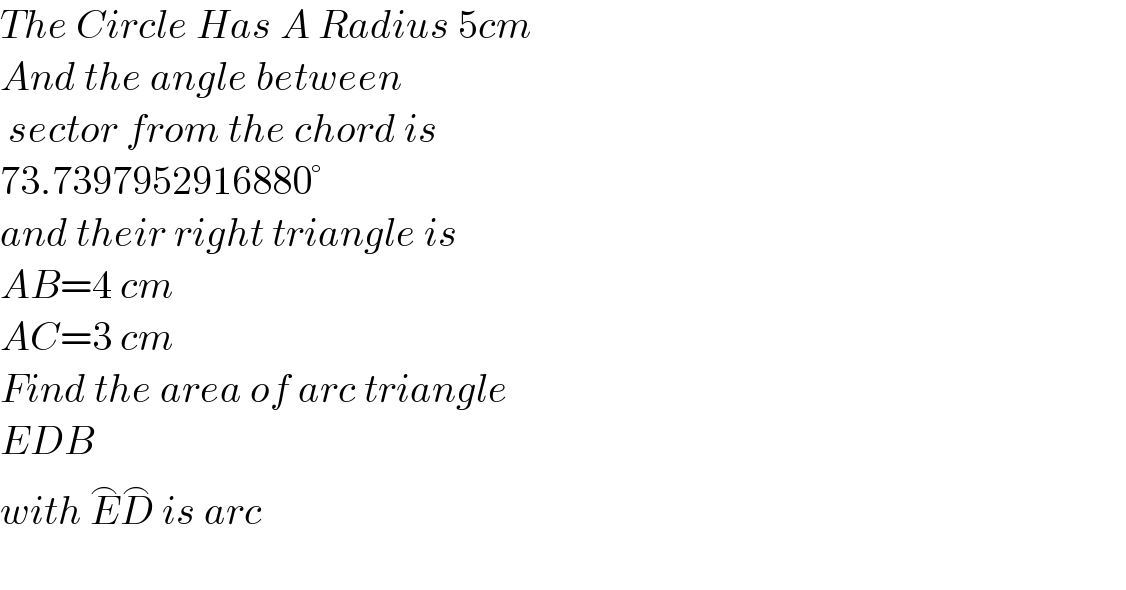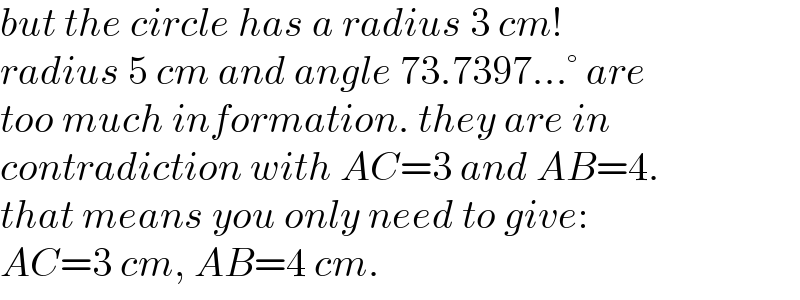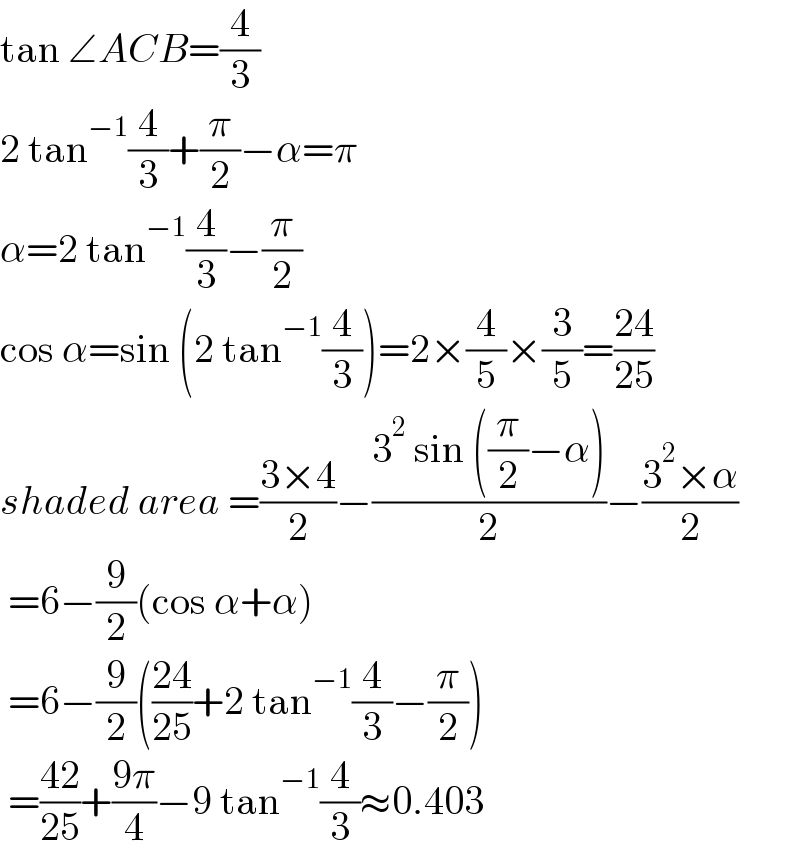Question Number 182178 by BagusSetyoWibowo last updated on 05/Dec/22

$${The}\:{Circle}\:{Has}\:{A}\:{Radius}\:\mathrm{5}{cm} \\ $$$${And}\:{the}\:{angle}\:{between} \\ $$$$\:{sector}\:{from}\:{the}\:{chord}\:{is} \\ $$$$\mathrm{73}.\mathrm{7397952916880}° \\ $$$${and}\:{their}\:{right}\:{triangle}\:{is} \\ $$$${AB}=\mathrm{4}\:{cm} \\ $$$${AC}=\mathrm{3}\:{cm} \\ $$$${Find}\:{the}\:{area}\:{of}\:{arc}\:{triangle} \\ $$$${EDB} \\ $$$${with}\:\overset{\frown} {{E}}\overset{\frown} {{D}}\:{is}\:{arc} \\ $$$$ \\ $$
Commented by BagusSetyoWibowo last updated on 05/Dec/22

Commented by mr W last updated on 05/Dec/22

$${but}\:{the}\:{circle}\:{has}\:{a}\:{radius}\:\mathrm{3}\:{cm}! \\ $$$${radius}\:\mathrm{5}\:{cm}\:{and}\:{angle}\:\mathrm{73}.\mathrm{7397}…°\:{are} \\ $$$${too}\:{much}\:{information}.\:{they}\:{are}\:{in}\: \\ $$$${contradiction}\:{with}\:{AC}=\mathrm{3}\:{and}\:{AB}=\mathrm{4}. \\ $$$${that}\:{means}\:{you}\:{only}\:{need}\:{to}\:{give}: \\ $$$${AC}=\mathrm{3}\:{cm},\:{AB}=\mathrm{4}\:{cm}. \\ $$
Answered by mr W last updated on 05/Dec/22

Commented by mr W last updated on 05/Dec/22

$$\mathrm{tan}\:\angle{ACB}=\frac{\mathrm{4}}{\mathrm{3}} \\ $$$$\mathrm{2}\:\mathrm{tan}^{−\mathrm{1}} \frac{\mathrm{4}}{\mathrm{3}}+\frac{\pi}{\mathrm{2}}−\alpha=\pi \\ $$$$\alpha=\mathrm{2}\:\mathrm{tan}^{−\mathrm{1}} \frac{\mathrm{4}}{\mathrm{3}}−\frac{\pi}{\mathrm{2}} \\ $$$$\mathrm{cos}\:\alpha=\mathrm{sin}\:\left(\mathrm{2}\:\mathrm{tan}^{−\mathrm{1}} \frac{\mathrm{4}}{\mathrm{3}}\right)=\mathrm{2}×\frac{\mathrm{4}}{\mathrm{5}}×\frac{\mathrm{3}}{\mathrm{5}}=\frac{\mathrm{24}}{\mathrm{25}} \\ $$$${shaded}\:{area}\:=\frac{\mathrm{3}×\mathrm{4}}{\mathrm{2}}−\frac{\mathrm{3}^{\mathrm{2}} \:\mathrm{sin}\:\left(\frac{\pi}{\mathrm{2}}−\alpha\right)}{\mathrm{2}}−\frac{\mathrm{3}^{\mathrm{2}} ×\alpha}{\mathrm{2}} \\ $$$$\:=\mathrm{6}−\frac{\mathrm{9}}{\mathrm{2}}\left(\mathrm{cos}\:\alpha+\alpha\right) \\ $$$$\:=\mathrm{6}−\frac{\mathrm{9}}{\mathrm{2}}\left(\frac{\mathrm{24}}{\mathrm{25}}+\mathrm{2}\:\mathrm{tan}^{−\mathrm{1}} \frac{\mathrm{4}}{\mathrm{3}}−\frac{\pi}{\mathrm{2}}\right) \\ $$$$\:=\frac{\mathrm{42}}{\mathrm{25}}+\frac{\mathrm{9}\pi}{\mathrm{4}}−\mathrm{9}\:\mathrm{tan}^{−\mathrm{1}} \frac{\mathrm{4}}{\mathrm{3}}\approx\mathrm{0}.\mathrm{403} \\ $$
